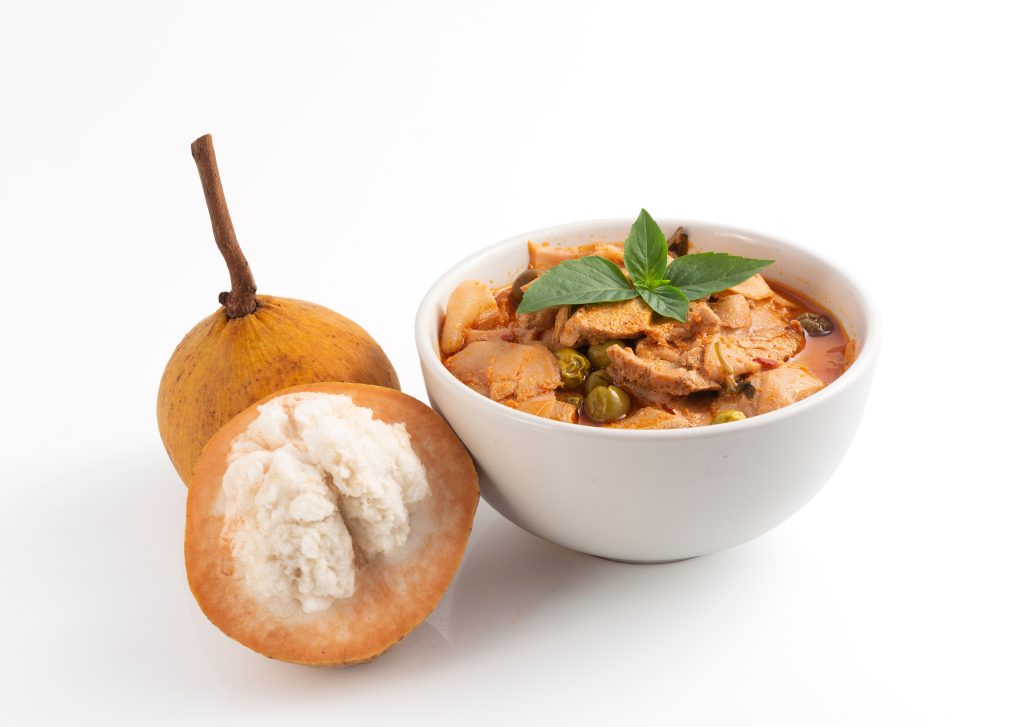The Santol fruit originates from the Malay Archipelago. It has a rounded or oval shape and thick skin in hues ranging from yellow to brown.
Table of Contents
What is a Santol Fruit?
The santol fruit, commonly referred to as Sentul, wild mangosteen, or cotton fruit, is a tropical fruit indigenous to Southeast Asian countries, notably Malaysia, the Philippines, Indonesia, and Thailand. The santol tree is also cultivated in India, Indochina, Sri Lanka, Puerto Rico, Costa Rica, Florida, and Hawaii.
It is characterized by its round or oval-shaped fruit with a tough and thick rind that varies in color from shades of green to yellow. There are two popular cultivars; red santol (Sandoricum Koetjape) and yellow santol (Sandoricum Nervosum).
The flesh of the santol fruit is white or yellow and has a delicious sweet and tangy taste that is often described as a blend of citrus and tropical flavors. It is widely known for its distinct juicy and moderately acidic taste.
Santol has various medicinal uses, including reducing fever (leaves), diarrhea (roots), and other parts of the plant help with easing dysentery. The wood of the tree is also helpful in construction. Santol seed extracts can repel mosquitoes because of their insecticidal properties.
The History of Santol Fruit
The Santol fruit is a native of Southeast Asia, primarily Thailand and the Philippines, and has gained global recognition owing to its delightful blend of sweetness and tartness. The fruit’s worldwide accessibility owes much to international trade, allowing individuals worldwide to relish its distinctive flavor and myriad health benefits.
Santol’s significance goes beyond its culinary appeal; it is pivotal in various traditions and festivities. In the Philippines, it is an integral ingredient in ceremonial delicacies consumed during religious occasions such as Easter and Christmas.
Cultural festivals that mandate a symbol of joy and abundance often use santol, given its refreshing taste and vibrant color.

What Does a Santol Fruit Taste Like?
Raw santol fruit has a distinct taste profile commonly characterized as sweet and tart, enriched with subtle pineapple and citrus notes. When cooked, the texture softens, and the flavor profile mellows, making it a preferred ingredient for desserts and jams.
How to Tell When Santol is Ripe
| Color | Ripe santol fruits exhibit a vibrant yellow or orange hue, showcasing a uniform skin complexion devoid of green patches. Although the precise shade may vary following the santol species, it should be explicitly distinguishable from its unripe green tint. |
| Texture | A ripe santol should exhibit slight flexibility, signifying its tenderness when gently pressed. |
| Scent | A pleasant and sweet fragrance characterizes a ripe santol. The absence of a noticeable scent or the presence of an unpleasant or sour smell might indicate that the fruit still needs to mature. |
| Smoothness/Roughness | Ripe santol fruits have glossy smooth skin. Throughout ripening, the roughness of the skin tends to diminish, giving way to a more refined and polished appearance. |
When shopping for santol, opting for ones with vivid yellow or orange peel is advised, as it signifies their ripeness. It is best to refrain from selecting fruits with any soft spots or blemishes.
Are Santol Fruit and Mangosteen Related?
Santol fruit and mangosteen are distinct from each other in various dimensions. For instance, Santol is characterized by a larger size and a thick, fibrous rind, whereas Mangosteen is relatively smaller with purple, thick skin.
Additionally, Santol has a distinctly sour taste, whereas mangosteen is renowned for its tangy and sweet flavor. Santol’s flesh is white, whereas mangosteen is white, juicy, and segmented.
Cooking with Santol Fruit
To properly prepare the fruit, it is recommended to thoroughly cleanse it under running water and subsequently peel off the outer skin with a sharp knife. The next step involves slicing the fruit into quarters or halves per the specific instructions of the recipe.
The santol fruit boasts remarkable versatility, lending itself to diverse cooking techniques. It holds significant importance in Thai, Indonesian, and Filipino cuisine.

Below are three delectable recipes that utilize this fruit in their preparation:
Sinigang na Santol (Sour Soup with Santol): This Filipino dish combines the tangy flavor of santol with savory broth, vegetables, and meat or seafood. The fruit adds a unique sour taste to the soup.
Santol Curry: In Thai cuisine, santol is used to make a flavorful curry. The fruit’s tanginess complements the rich and spicy curry sauce. The curry is often prepared with vegetables, meat, or shrimp.
Sayur Asem Santol (Sour Tamarind Soup with Santol): This Indonesian dish features santol in a sour tamarind-based soup. The soup is typically cooked with various vegetables, such as corn, string beans, and cabbage. Santol adds a unique tartness to the dish.
How to Store Santol Fruit
For optimal storage of santol fruit, it is recommended to maintain an ambient temperature and keep them on a kitchen counter away from direct sunlight. This will facilitate natural ripening and offer a shelf life of 3-5 days.
Another storage option is refrigerating ripe santol fruits in a ventilated plastic bag, providing up to a week of shelf life. Freezing is not advised as it can have adverse effects on the fruit’s texture.
While drying santol fruits is possible, it is mainly utilized for making jams or preserves rather than storing the fruit in its natural form.
Nutritional Benefits of Santol Fruit
Santol boasts a wealth of nutritional value and can improve health in various ways. It serves as an excellent source of dietary fiber, promoting digestion while inducing feelings of fullness.
High in vitamin C, it heightens immunity and boosts collagen production. Santol is also rich in calcium and phosphorus, strengthening teeth and bones.
Where to Purchase Santol Fruit
The Santol fruit is sold in farmers’ markets and specialty stores that showcase exotic fruits. Its availability may differ based on the region, but it is prominently obtainable in Southeast Asia, especially in the Philippines. The summer season is usually the optimal time to acquire this fruit.

